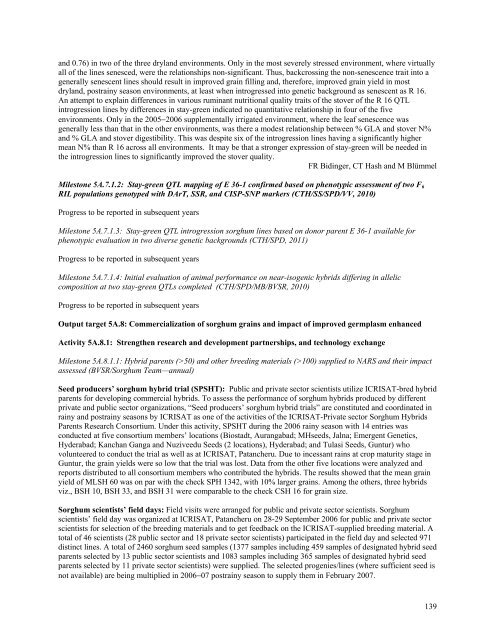ICRISAT Archival Report 2006 - The seedlings of success in the ...
ICRISAT Archival Report 2006 - The seedlings of success in the ...
ICRISAT Archival Report 2006 - The seedlings of success in the ...
Create successful ePaper yourself
Turn your PDF publications into a flip-book with our unique Google optimized e-Paper software.
and 0.76) <strong>in</strong> two <strong>of</strong> <strong>the</strong> three dryland environments. Only <strong>in</strong> <strong>the</strong> most severely stressed environment, where virtually<br />
all <strong>of</strong> <strong>the</strong> l<strong>in</strong>es senesced, were <strong>the</strong> relationships non-significant. Thus, backcross<strong>in</strong>g <strong>the</strong> non-senescence trait <strong>in</strong>to a<br />
generally senescent l<strong>in</strong>es should result <strong>in</strong> improved gra<strong>in</strong> fill<strong>in</strong>g and, <strong>the</strong>refore, improved gra<strong>in</strong> yield <strong>in</strong> most<br />
dryland, postra<strong>in</strong>y season environments, at least when <strong>in</strong>trogressed <strong>in</strong>to genetic background as senescent as R 16.<br />
An attempt to expla<strong>in</strong> differences <strong>in</strong> various rum<strong>in</strong>ant nutritional quality traits <strong>of</strong> <strong>the</strong> stover <strong>of</strong> <strong>the</strong> R 16 QTL<br />
<strong>in</strong>trogression l<strong>in</strong>es by differences <strong>in</strong> stay-green <strong>in</strong>dicated no quantitative relationship <strong>in</strong> four <strong>of</strong> <strong>the</strong> five<br />
environments. Only <strong>in</strong> <strong>the</strong> 2005−<strong>2006</strong> supplementally irrigated environment, where <strong>the</strong> leaf senescence was<br />
generally less than that <strong>in</strong> <strong>the</strong> o<strong>the</strong>r environments, was <strong>the</strong>re a modest relationship between % GLA and stover N%<br />
and % GLA and stover digestibility. This was despite six <strong>of</strong> <strong>the</strong> <strong>in</strong>trogression l<strong>in</strong>es hav<strong>in</strong>g a significantly higher<br />
mean N% than R 16 across all environments. It may be that a stronger expression <strong>of</strong> stay-green will be needed <strong>in</strong><br />
<strong>the</strong> <strong>in</strong>trogression l<strong>in</strong>es to significantly improved <strong>the</strong> stover quality.<br />
FR Bid<strong>in</strong>ger, CT Hash and M Blümmel<br />
Milestone 5A.7.1.2: Stay-green QTL mapp<strong>in</strong>g <strong>of</strong> E 36-1 confirmed based on phenotypic assessment <strong>of</strong> two F 6<br />
RIL populations genotyped with DArT, SSR, and CISP-SNP markers (CTH/SS/SPD/VV, 2010)<br />
Progress to be reported <strong>in</strong> subsequent years<br />
Milestone 5A.7.1.3: Stay-green QTL <strong>in</strong>trogression sorghum l<strong>in</strong>es based on donor parent E 36-1 available for<br />
phenotypic evaluation <strong>in</strong> two diverse genetic backgrounds (CTH/SPD, 2011)<br />
Progress to be reported <strong>in</strong> subsequent years<br />
Milestone 5A.7.1.4: Initial evaluation <strong>of</strong> animal performance on near-isogenic hybrids differ<strong>in</strong>g <strong>in</strong> allelic<br />
composition at two stay-green QTLs completed (CTH/SPD/MB/BVSR, 2010)<br />
Progress to be reported <strong>in</strong> subsequent years<br />
Output target 5A.8: Commercialization <strong>of</strong> sorghum gra<strong>in</strong>s and impact <strong>of</strong> improved germplasm enhanced<br />
Activity 5A.8.1: Streng<strong>the</strong>n research and development partnerships, and technology exchange<br />
Milestone 5A.8.1.1: Hybrid parents (>50) and o<strong>the</strong>r breed<strong>in</strong>g materials (>100) supplied to NARS and <strong>the</strong>ir impact<br />
assessed (BVSR/Sorghum Team—annual)<br />
Seed producers’ sorghum hybrid trial (SPSHT): Public and private sector scientists utilize <strong>ICRISAT</strong>-bred hybrid<br />
parents for develop<strong>in</strong>g commercial hybrids. To assess <strong>the</strong> performance <strong>of</strong> sorghum hybrids produced by different<br />
private and public sector organizations, “Seed producers’ sorghum hybrid trials” are constituted and coord<strong>in</strong>ated <strong>in</strong><br />
ra<strong>in</strong>y and postra<strong>in</strong>y seasons by <strong>ICRISAT</strong> as one <strong>of</strong> <strong>the</strong> activities <strong>of</strong> <strong>the</strong> <strong>ICRISAT</strong>-Private sector Sorghum Hybrids<br />
Parents Research Consortium. Under this activity, SPSHT dur<strong>in</strong>g <strong>the</strong> <strong>2006</strong> ra<strong>in</strong>y season with 14 entries was<br />
conducted at five consortium members’ locations (Biostadt, Aurangabad; MHseeds, Jalna; Emergent Genetics,<br />
Hyderabad; Kanchan Ganga and Nuziveedu Seeds (2 locations), Hyderabad; and Tulasi Seeds, Guntur) who<br />
volunteered to conduct <strong>the</strong> trial as well as at <strong>ICRISAT</strong>, Patancheru. Due to <strong>in</strong>cessant ra<strong>in</strong>s at crop maturity stage <strong>in</strong><br />
Guntur, <strong>the</strong> gra<strong>in</strong> yields were so low that <strong>the</strong> trial was lost. Data from <strong>the</strong> o<strong>the</strong>r five locations were analyzed and<br />
reports distributed to all consortium members who contributed <strong>the</strong> hybrids. <strong>The</strong> results showed that <strong>the</strong> mean gra<strong>in</strong><br />
yield <strong>of</strong> MLSH 60 was on par with <strong>the</strong> check SPH 1342, with 10% larger gra<strong>in</strong>s. Among <strong>the</strong> o<strong>the</strong>rs, three hybrids<br />
viz., BSH 10, BSH 33, and BSH 31 were comparable to <strong>the</strong> check CSH 16 for gra<strong>in</strong> size.<br />
Sorghum scientists’ field days: Field visits were arranged for public and private sector scientists. Sorghum<br />
scientists’ field day was organized at <strong>ICRISAT</strong>, Patancheru on 28-29 September <strong>2006</strong> for public and private sector<br />
scientists for selection <strong>of</strong> <strong>the</strong> breed<strong>in</strong>g materials and to get feedback on <strong>the</strong> <strong>ICRISAT</strong>-supplied breed<strong>in</strong>g material. A<br />
total <strong>of</strong> 46 scientists (28 public sector and 18 private sector scientists) participated <strong>in</strong> <strong>the</strong> field day and selected 971<br />
dist<strong>in</strong>ct l<strong>in</strong>es. A total <strong>of</strong> 2460 sorghum seed samples (1377 samples <strong>in</strong>clud<strong>in</strong>g 459 samples <strong>of</strong> designated hybrid seed<br />
parents selected by 13 public sector scientists and 1083 samples <strong>in</strong>clud<strong>in</strong>g 365 samples <strong>of</strong> designated hybrid seed<br />
parents selected by 11 private sector scientists) were supplied. <strong>The</strong> selected progenies/l<strong>in</strong>es (where sufficient seed is<br />
not available) are be<strong>in</strong>g multiplied <strong>in</strong> <strong>2006</strong>−07 postra<strong>in</strong>y season to supply <strong>the</strong>m <strong>in</strong> February 2007.<br />
139

















